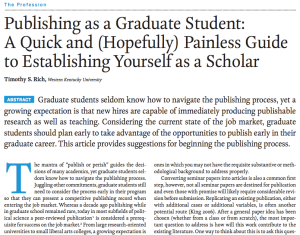 A new article in Political Science & Politics claims that replication can be a “potential route” to get a class paper published early in your career. Below are tips from the paper how to make this work.
A new article in Political Science & Politics claims that replication can be a “potential route” to get a class paper published early in your career. Below are tips from the paper how to make this work.
In “Publishing as a Graduate Student: A Quick and (Hopefully) Painless Guide to Establishing Yourself as a Scholar”, Timothy S. Rich stresses that seminar papers can be converted into articles as a “common first step”. He warns, though, that “not all seminar papers are destined for publication and even those with promise will likely require considerable revision before submission.” Replication as a class project seems well suited as a first publishing project for a grad student:
“Replicating an existing publication, either with additional cases or additional variables, is often another potential route (King 2006). After a general paper idea has been chosen (whether from a class or from scratch), the most important question to address is how will this work contribute to the existing literature. One way to think about this is to ask this question: what is the take-home message of this paper and what is the value added to the general literature on this topic? Contributions could be theoretical (e.g., challenging existing theory or testing such theories in a new way), methodological (e.g., quantitative analysis of a topic largely only addressed through qualitative means), the use of original data or case selection (e.g., a least-likely case), or even a combination of these factors.”
Tips for publishing beyond replication
- For a replication paper as well as any other paper, most important is to have a “hook” in your paper, and ideally this is “challenging the conventional wisdom.” Focus on only one argument in the paper.
- Pick topics in which you already know the literature well and that fit into your research agenda.
- Follow the format of published articles on your topic (generally: intro, roadmap, review, method, analysis, conclusion).
- Send the paper to peers and professors before submission – you’ll get their tips faster.
- Present at a conference. If the paper was well received (“largely positive feedback”), submit.
- Submit to journals matching your audience, previous papers on the same topic, high reputation journals (but stay realistic).
- Don’t ignore a second-tier journal if it has a fast turn-around – especially if you’re on the market soon.
- A solo-authored publication shows your ability be an independent researcher, you need at least one of these.
The article

Timothy S. Rich (2013). Publishing as a Graduate Student: A Quick and (Hopefully) Painless Guide to Establishing Yourself as a Scholar. PS: Political Science & Politics, 46, pp 376-379. doi:10.1017/S104909651300005X.
[…] up on my post on how to publish as a grad student, here’s a video on scooping anxiety. If you share your […]
LikeLike
[…] might also want to read “Getting published by replicating work“, “Publishing as a grad student: replication helps” and other articles on replication […]
LikeLike